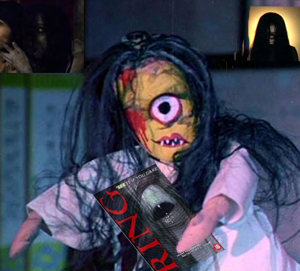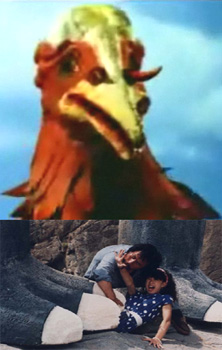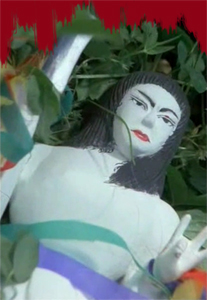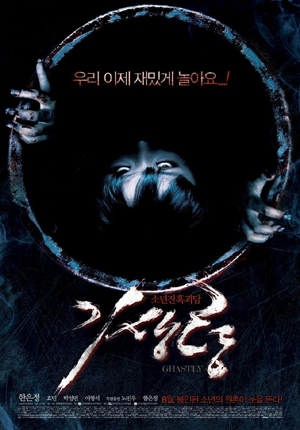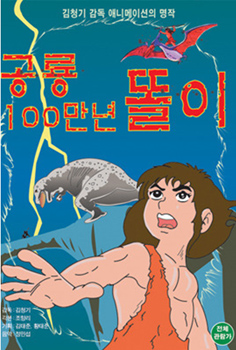Countdown to Halloween D-5: Zzu-Zzu
27th October 2011
Today, while I was preparing a post for the next monster on the Obscure Monster Halloween Countdown when a friend looked over my shoulder and said excitedly, “You should write about Baby Dinosaur Zzu-Zzu!” “You mean Young-gu and Dinosaur Zzu-Zzu?” I asked. That was a movie I had briefly considered and dismissed. “Yeah!” he replied, “I saw it when I was about nine or ten years old. It was a lot of fun. You have to write about it.” Well, since I have to write about it, I will.
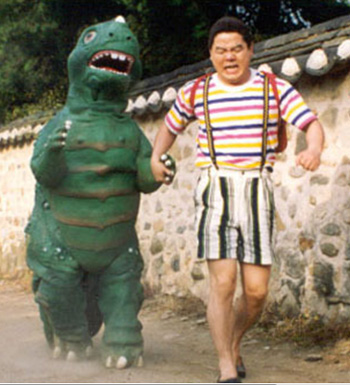 What really made me agree to write about the movie was the image pictured right. Warning! Do NOT look directly at this still photo! The absolute hideousness could possibly cause blindness. You all know what I’m talking about. Not the strange reptile creature holding hands with Young-gu. It’s that horrible collection of verticle and horizontal stripes. And the shorts with suspenders combo. I don’t think I have ever seen anything so terrible in my life. And it appears throughout the movie.. Young-gu never once changes what he’s wearing except for a brief scene that is even worse when he takes off his shirt. Yes, it is true. After my friend told me I had to write about the movie, I felt I first should actually see it. I was a little reluctant to do so being familar with early Shim Hyeong-rae films and his character Young-gu. As an adult, his films are hard to watch. He has often been blamed for making childish films and his detractors would have a point except for the fact that they Shim’s films were made for children. In nearly all of his films, Hyeong-rae portrays himself as an adult-sized child, whether he is in the Uleme series, the Young-gu movies (Young-gu and Ddaengchili, Young-gu and Dracula..), or the direct-to-video Hyeong-rae series (Hyeong-rae and the Hulk, Masked Hyeong-rae and the Goblins…). By playing the child, no matter how unconvincing he is to the mature eye, he provides children with an identification figure.. a character or friend with whom they can imagine sharing impossible adventures or whom they replace in their imaginations with themselves.
What really made me agree to write about the movie was the image pictured right. Warning! Do NOT look directly at this still photo! The absolute hideousness could possibly cause blindness. You all know what I’m talking about. Not the strange reptile creature holding hands with Young-gu. It’s that horrible collection of verticle and horizontal stripes. And the shorts with suspenders combo. I don’t think I have ever seen anything so terrible in my life. And it appears throughout the movie.. Young-gu never once changes what he’s wearing except for a brief scene that is even worse when he takes off his shirt. Yes, it is true. After my friend told me I had to write about the movie, I felt I first should actually see it. I was a little reluctant to do so being familar with early Shim Hyeong-rae films and his character Young-gu. As an adult, his films are hard to watch. He has often been blamed for making childish films and his detractors would have a point except for the fact that they Shim’s films were made for children. In nearly all of his films, Hyeong-rae portrays himself as an adult-sized child, whether he is in the Uleme series, the Young-gu movies (Young-gu and Ddaengchili, Young-gu and Dracula..), or the direct-to-video Hyeong-rae series (Hyeong-rae and the Hulk, Masked Hyeong-rae and the Goblins…). By playing the child, no matter how unconvincing he is to the mature eye, he provides children with an identification figure.. a character or friend with whom they can imagine sharing impossible adventures or whom they replace in their imaginations with themselves.
The plot of the movie follows the British movie Gorgo (1961) and the 1967 Japanese film Monster from a Prehistoric Planet starring Gappa (a monster that should be on somebody’s obscure creature list) In all of these films, somebody finds a giant egg or a baby, unknown beast and decides to take it home and then are shocked with the parent or parents of the hatchling come searching for it. In Young-gu and Dinosaur Zzu-Zzu (1993), (NOT “Princess Zzu-Zzu as the KMDb calls it— somebody there mixed up the words Gongryong with Gongju. They are not interchangable), Young-gu finds a giant egg in a cave. The egg then chases him (?) and nearly crushes Young-gu before coming to a hault and hatching.
At first terrified by the little dinosaur that bears more than a passing resemblence to the original Yonggary from Yonggary, Monster from the Deep (1967), Young-gu soon finds himself coming to its rescue when a gang of children attack the beast out of fear. The police get involved as well, so Young-gu hides to monster in his room with his stuffed toys like in E.T. He might have evaded the police but Young-gu and the little dinosaur run afoul of three thieves who having seen the dinosaur, want to capture and sell it to the highest bidder. After several misadventures, the thieves finally succeed and take the little dinosaur and the kidnapped Young-gu to Seoul.
It turns out that they left the village just in time. The real threat to humanity shows up– Zzu-Zzu’s mother. She appears by breaking through the side of a mountain in a scene that was clearly inspired by Yonggary and that is done at least as well as that more famous monster. Her major fault is that she comes at the 50 minute mark– That meant 50 minutes with no real monster.. or did it? Little Zzu-Zzu made it quite clear that she did not eat vegetables or grains. Clearly, she was carniverous… I kept waiting for her to turn on the thieves and eat them. But she doesn’t get the chance. Her mother finally tracks them down in Seoul, after destroying much of the city, finally attacks the building where Zzu-Zzu is hidden and melts her kidnappers with her flame breath.
That turn of events seemed surprisingly out of place in a movie clearly aimed at very young children as did the ultimate, and quite bloody fate of Zzu-Zzu’s mother as she bleeds out on the street and dies. The soldiers then turn their guns on Zzu-Zzu and….
This film was Shim Hyeong-rae’s first attempt at making a monster movie and he has many others to his name..Tyrano’s Claw, Young-gu and the Space Monster, Dragon Tucca, Yonggary and D-War. Three of those are possible candidates for this list, but tomorrow I be taking a look at a 1961 movie featuring a vampiric vine.
Posted in 1990s, Uncategorized | Comments Off

